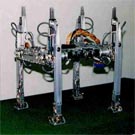Six-legged robots would help to make lunar bases mobile
 London, April 5: NASA engineers are developing a giant, six-legged robot that would be able to pick up and move a future moon base thousands of kilometers across the lunar surface, allowing astronauts to explore a much wider area.
London, April 5: NASA engineers are developing a giant, six-legged robot that would be able to pick up and move a future moon base thousands of kilometers across the lunar surface, allowing astronauts to explore a much wider area.
According to a report in New Scientist, NASA has earlier said that it wants to set up a base at a fixed location on the Moon after initially returning humans there in 2020.
Now, the development of a gargantuan robotic vehicle called ATHLETE (All-Terrain Hex-Legged Extra-Terrestrial Explorer) would change that.
Measuring about 7.5 metres wide, with legs more than 6 metres long, the robot could act essentially like a turtle, carrying the astronauts’ living quarters around on its back.
Engineers at NASA’s Jet Propulsion Laboratory (JPL) in Pasadena, California, US, who are now testing two small-scale prototypes of the robot, designed it.
The astronauts’ 15-tonne living quarters, or habitat, could be mounted on ATHLETE before sending it to the Moon in a lunar lander. That would solve one major problem for NASA – how to lift the habitat off the lander, whose cargo area may sit up to 6 metres above the ground, and set it down at a desired location.
According to JPL’s Brian Wilcox, who heads the ATHLETE project, “ATHLETE’s wheel-tipped legs are so long, it just steps right off and carries the payload anywhere you want.”
In Wilcox’s scenario, the habitat would stay permanently attached to ATHLETE, which could roam from place to place and simply squat down to bring the habitat door close enough to the ground for astronauts to get in and out.
Even with its turtle-like pace of less than 10 km/h, ATHLETE could traverse huge swaths of the Moon’s surface. At an average speed of 5 km/h, it could travel 1000 kilometers in eight days, which is a significant fraction of the Moon’s circumference of about 11,000 kilometers.
“We proposed basically pole to pole exploration, where you’d land at one pole and explore sites down through the equatorial region and end up at the other pole,” said Wilcox. “We’re working on designs for wheel drives and so on – motors, bearings, gears – that have 10,000 kilometers of life,” he added.
The six-legged robot would be powered by the habitat’s solar arrays, which could also store power in fuel cells.
Though ATHLETE would normally drive around the lunar surface, it could switch to walking whenever it encounters very bumpy ground or its wheels got mired in deep soil.
NASA is planning to test the mobile base scenario in a desert location in the southwestern US starting in late 2008. (ANI